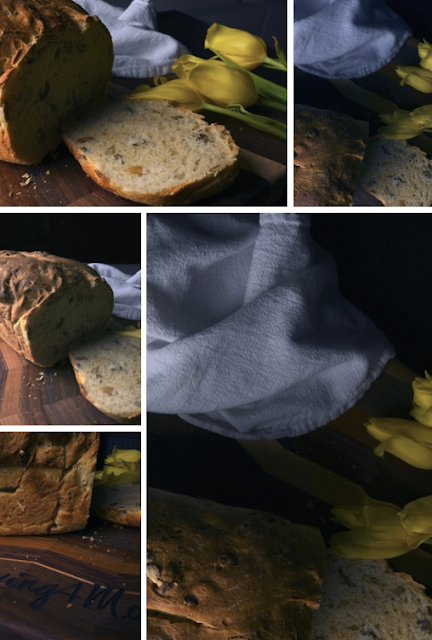Pickle Pumpkin Seed Sourdough Bread
A freshly baked loaf of sourdough bread (using 100-year-old sourdough starter, of course) is such a clever way to create contrasting flavors and textures.
A crispy, oven-browned crust with a soft and tender center filled with pockets of aromatic, dill-seasoned, and salted pumpkin seeds yields an even greater amalgamation of sensual pleasures.
Warm, slathered with butter – topped with eggs - or as an accompaniment and base for your favorite sandwich, who needs anything more? I’m just Craving4More.
Pickle Pumpkin Seed Sourdough Bread
1 recipe homemade sourdough bread*
3/4 cup Trader Joe’s Dill Pickle Pumpkin Seeds
Follow recipes as directed, folding the pesto into the bread dough, on the first rise.
*Homemade Sourdough Bread:
3/4 cup homemade sourdough starter**
3 1/2 – 4 cups all-purpose flour
1 1/2 cups warm water
1 Tbs. olive oil
1 tsp. sea salt
After feeding your starter for 12-24 hours, reserve 1/4 cup for the next batch and the next time to feed (1 week) and add the flour (3 1/2-4 cups, depending on the humidity, you know what dough feels like), warm water, oil, and salt.
Mix well.
Allow the dough to rest for 15-20 minutes.
Mix again.
Rest and cover with a loose towel for 3 hours.
With flour-dusted hands, FOLD the dough to remove the air bubbles.
DO NOT KNEAD or PUNCH. Fold 5-10 times.
This Sourdough Bread recipe calls for you to “fold the dough” a couple of times during the bulk fermentation (first rise), and I thought it might be helpful to some people if I explained what that means. (If you are a seasoned dough-folder, you can skip this section.)
The folding helps to encourage those long gluten strands and create those lovely sourdough bubbles.
Many, if not most, bread recipes call for you to punch down the dough after rising.
Punching down the dough does a number of things.
Most importantly, it removes some of the gas bubbles from the dough and redistributes the yeast cells, sugars, and moisture so that they can ferment and rise again during the proofing stage.
Folding yields similar results: it too expels the carbon dioxide produced during fermentation, strengthens the dough by stretching the gluten strands, and redistributes cells, sugars, moisture, and heat spots in the dough to even out the rising.
-Renée, The Good-Hearted Woman, Easy Sourdough Bread
Transfer to a flower-dusted proofing bowl and cover loosely with a towel for another 1-3 hours. (If you do not have a proofing bowl, transfer to a parchment-lined Dutch oven and cover with a towel to proof).
Preheat the oven to 450 degrees.
Transfer the proofed loaf to a parchment-lined baking dish.
Bake for 30 minutes, until golden brown.
OR place the Dutch oven in the hot oven and bake until golden brown.
BEST BREAD EVER!
**FEED your starter. This starter is fairly fresh, fed only 12 hours previously. To feed: 1/4 cup sourdough starter + 1 cup warm water + 1 cup all-purpose flour. Mix the three ingredients together in a large (nonmetal) bowl. Cover with a kitchen towel and ferment in a warmish, well-ventilated area for 12-24 hours. The longer you ferment, the more bubbles, and the more sour it becomes. YES!







Comments
Post a Comment